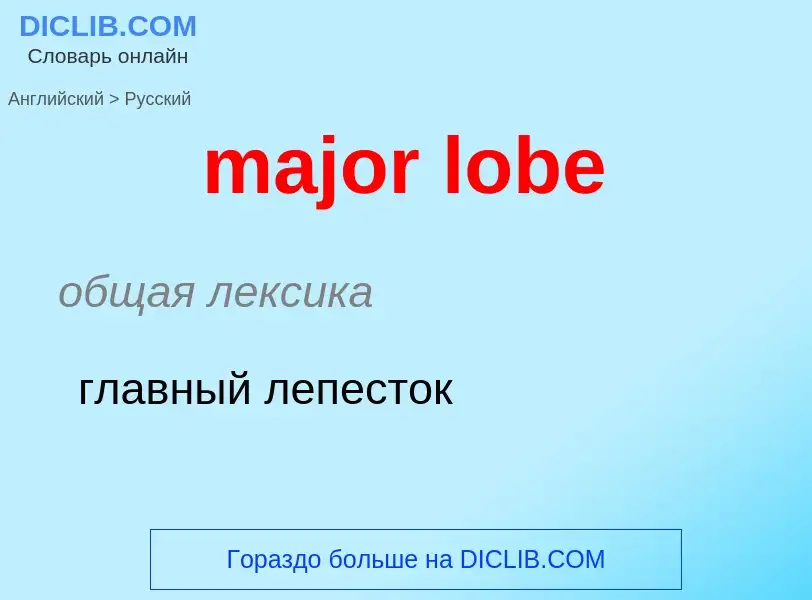Перевод и анализ слов искусственным интеллектом ChatGPT
На этой странице Вы можете получить подробный анализ слова или словосочетания, произведенный с помощью лучшей на сегодняшний день технологии искусственного интеллекта:
- как употребляется слово
- частота употребления
- используется оно чаще в устной или письменной речи
- варианты перевода слова
- примеры употребления (несколько фраз с переводом)
- этимология
major lobe - перевод на русский
общая лексика
главный лепесток
существительное
общая лексика
майор
синоним
['meɪdʒə]
общая лексика
майор (младшее воинское звание в категории старшего офицерского состава сухопутных войск; воинское звание в категории старшего офицерского состава морской пехоты, соответствующее подполковнику сухопутных войск)
более важный
больший
большой
главный
мажорный
основной
сквозной
старший
юриспруденция
совершеннолетний (достигший 18 лет, до 1970-21 года)
старший (из двух или трёх братьев, а тж. второй из четырёх братьев - учащихся привилегированной частной средней школы [public school] или приготовительной школы [preparatory school]; ставится после фамилии, напр., Smith major или Smith ma.)
синоним
Смотрите также
прилагательное
['meidʒə]
общая лексика
больший
более важный
значительный
главный
крупный
относящийся к большинству
старший (ставится после фамилии старшего брата или старшего однофамильца, если они учатся в одной школе - в Великобритании)
больший, более важный
старший
юриспруденция
совершеннолетний
музыка
мажорный
большой (об интервале)
существительное
['meidʒə]
общая лексика
майор
обыкн. большая нефтяная компания
юриспруденция
совершеннолетний
логика
большая посылка (силлогизма)
главная посылка (в силлогизме)
музыка
мажор
американизм
главный
основной предмет специализации (в колледже)
профилирующая дисциплина (в колледже)
спорт
команда высшей лиги
глагол
американизм
специализироваться (о студенте)
специализироваться по какому-л. предмету (в колледже)
Определение
Википедия
In antenna engineering, sidelobes are the lobes (local maxima) of the far field radiation pattern of an antenna or other radiation source, that are not the main lobe.
The radiation pattern of most antennas shows a pattern of "lobes" at various angles, directions where the radiated signal strength reaches a maximum, separated by "nulls", angles at which the radiated signal strength falls to zero. This can be viewed as the diffraction pattern of the antenna. In a directional antenna in which the objective is to emit the radio waves in one direction, the lobe in that direction is designed to have a larger field strength than the others; this is the "main lobe". The other lobes are called "sidelobes", and usually represent unwanted radiation in undesired directions. The sidelobe directly behind the main lobe is called the back lobe. The longer the antenna relative to the radio wavelength, the more lobes its radiation pattern has. In transmitting antennas, excessive sidelobe radiation wastes energy and may cause interference to other equipment. Another disadvantage is that confidential information may be picked up by unintended receivers. In receiving antennas, sidelobes may pick up interfering signals, and increase the noise level in the receiver.
The power density in the sidelobes is generally much less than that in the main beam. It is generally desirable to minimize the sidelobe level (SLL), which is measured in decibels relative to the peak of the main beam. The main lobe and sidelobes occur for both transmitting and receiving. The concepts of main and sidelobes, radiation pattern, aperture shapes, and aperture weighting, apply to optics (another branch of electromagnetics) and in acoustics fields such as loudspeaker and sonar design, as well as antenna design.
Because an antenna's far field radiation pattern is a Fourier Transform of its aperture distribution, most antennas will generally have sidelobes, unless the aperture distribution is a Gaussian, or if the antenna is so small as to have no sidelobes in the visible space. Larger antennas have narrower main beams, as well as narrower sidelobes. Hence, larger antennas have more sidelobes in the visible space (as the antenna size is increased, sidelobes move from the evanescent space to the visible space).

![A typical antenna radiation pattern in [[cartesian coordinate system]] representation showing sidelobes. A typical antenna radiation pattern in [[cartesian coordinate system]] representation showing sidelobes.](https://commons.wikimedia.org/wiki/Special:FilePath/Typical Antenna Pattern.jpg?width=200)
![A typical [[radiation pattern]] of [[phased array]]s whose inter-element spacing is greater than half a wavelength, hence the radiation pattern has grating lobes. A typical [[radiation pattern]] of [[phased array]]s whose inter-element spacing is greater than half a wavelength, hence the radiation pattern has grating lobes.](https://commons.wikimedia.org/wiki/Special:FilePath/Typical antenna pattern with grating lobes.jpg?width=200)
![Brazil]]}} Brazil]]}}](https://commons.wikimedia.org/wiki/Special:FilePath/Major Exército-V.gif?width=200)
![[[Canada]]}} [[Canada]]}}](Cdn-Army-Maj(OF-3)-2014 - Copy.svg)
![[[Estonia]]}} [[Estonia]]}}](https://commons.wikimedia.org/wiki/Special:FilePath/ES-Army-OF3.png?width=200)
![Georgia]]}} Georgia]]}}](https://commons.wikimedia.org/wiki/Special:FilePath/Georgia Army OF-4.png?width=200)
![[[Iran]]}} [[Iran]]}}](https://commons.wikimedia.org/wiki/Special:FilePath/Sargord.png?width=200)
![[[Malaysia]]}} [[Malaysia]]}}](https://commons.wikimedia.org/wiki/Special:FilePath/Major of Malaysian Army.png?width=200)
![[[Romania]]}} [[Romania]]}}](https://commons.wikimedia.org/wiki/Special:FilePath/RO-Army-OF3.png?width=200)
![[[Sweden]]}} [[Sweden]]}}](https://commons.wikimedia.org/wiki/Special:FilePath/OF-3 Major.jpg?width=200)
![Brazil]]}} Brazil]]}}](https://commons.wikimedia.org/wiki/Special:FilePath/Major-vertical fab.gif?width=200)






